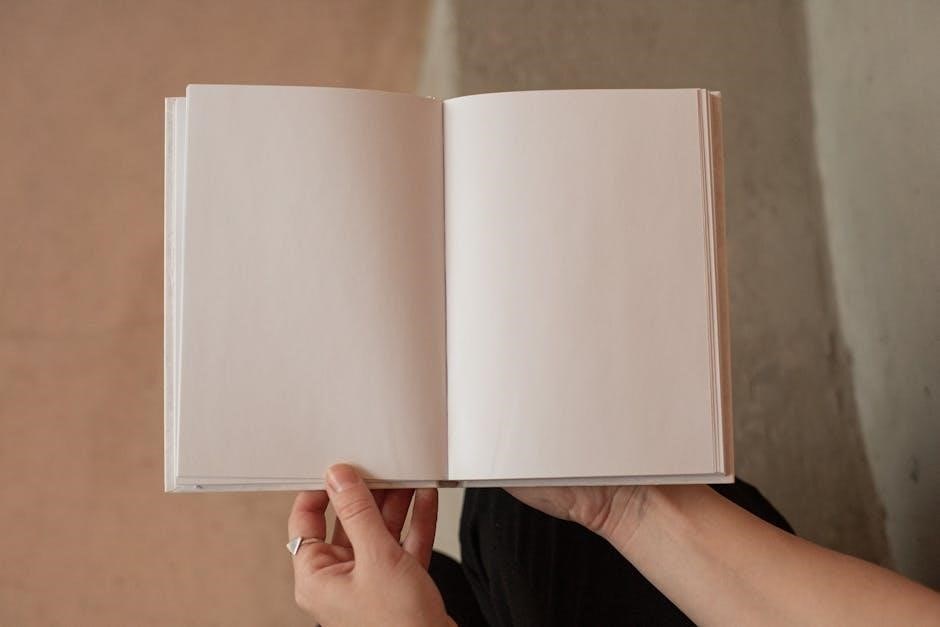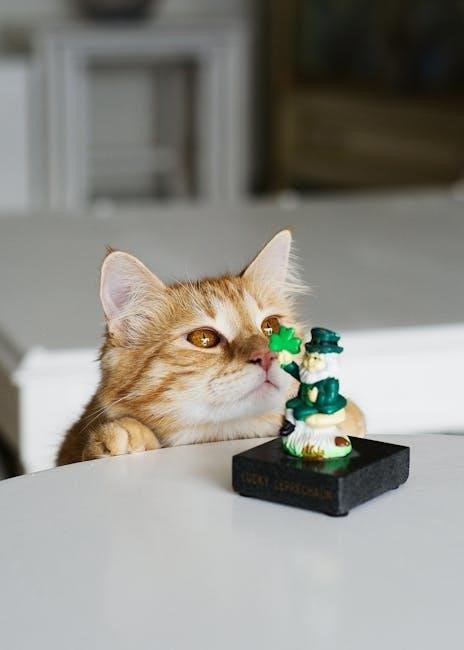Leprechauns are small, mischievous fairies in Irish folklore, often depicted as cobblers hiding pots of gold. Their stories teach logic and problem-solving, making them engaging educational tools.
Origins and Evolution of Leprechaun Stories
Leprechaun tales originated in Irish folklore, rooted in mythical fairies and cobblers. These stories evolved over centuries, blending humor and magic. Early depictions portrayed leprechauns as cunning tricksters, while modern adaptations often highlight their educational value, teaching logic and problem-solving. The folklore has been enriched by cultural traditions, making leprechauns a beloved and enduring symbol of Irish heritage. Their evolution reflects the dynamic nature of storytelling, adapting to societal changes while retaining their timeless charm and relevance.

Key Characteristics of Leprechauns
Leprechauns are small, bearded men in Irish folklore, known for their mischievous, cunning nature and elusive behavior. Often cobblers, they love trickery and are famous for hiding pots of gold.
Mischievous Nature and Practical Jokes
Leprechauns are renowned for their mischievous nature and love of practical jokes. They often play tricks on humans, such as hiding small items or leading them on wild goose chases. Their cunning and quick wit make them master pranksters, always staying one step ahead. While their antics can be frustrating, they are rarely harmful, reflecting their playful and cheeky personalities. These traits make leprechauns both entertaining and memorable figures in Irish folklore, embodying the spirit of light-hearted trickery and cleverness.
The Legend of the Pot of Gold
The legend of the pot of gold is a cornerstone of leprechaun folklore. According to stories, leprechauns hide their gold at the end of the rainbow, where it remains elusive to humans. This treasure symbolizes good fortune and cleverness, as the leprechaun’s cunning nature ensures it remains protected. The pot of gold serves as both a motivator for humans to outwit the leprechaun and a testament to their magical wisdom. This iconic imagery has become synonymous with Irish culture and continues to captivate imaginations worldwide.

Leprechaun Traps and Traditions
Leprechaun traps are a fun and creative tradition, often built by children to catch these mischievous fairies. These traps showcase cleverness and imagination, tying into St. Patrick’s Day festivities.
Building Leprechaun Traps: Tips and Ideas
Building leprechaun traps is a fun and imaginative activity, often involving children. Use shiny objects like gold coins or small treasures to lure them. Incorporate clever mechanisms, such as traps that spring shut when triggered. Involve kids in the design process to encourage creativity and problem-solving. These traps not only entertain but also teach logic and critical thinking. Make it a family tradition to build elaborate traps each St. Patrick’s Day, fostering bonding and creativity. Remember, the goal is to outsmart these mischievous fairies!
St. Patrick’s Day Activities and Customs

St. Patrick’s Day is celebrated with parades, wearing green, and Irish music. Families often share stories of leprechauns and their pots of gold. Building leprechaun traps is a popular activity, teaching kids logic and creativity. Traditional Irish dishes like corned beef and cabbage are enjoyed. Many schools incorporate folklore into lessons, using stories to teach language arts. This festive day blends fun and education, making it a cherished tradition for both children and adults alike.

Educational Value of Leprechaun Stories
Leprechaun stories offer educational benefits by teaching logic, problem-solving, and creativity. They also enhance language arts skills through engaging narratives and cultural enrichment.
Teaching Logic and Problem-Solving Skills
Leprechaun stories foster critical thinking and creativity, encouraging children to solve puzzles and riddles. Building traps, for instance, teaches problem-solving and logical reasoning. These tales inspire kids to think strategically, fostering intellectual growth through fun, interactive challenges. By engaging with leprechaun folklore, children develop essential skills that translate to real-world problem-solving. The metaphorical nature of these stories makes learning logic an enjoyable and memorable experience.
Using Folklore in Language Arts Education
Leprechaun stories are a vibrant tool for teaching language arts, fostering creativity and comprehension. They inspire imaginative writing, such as crafting tales about leprechaun adventures or designing traps. Reading these stories aloud enhances fluency and engagement, while discussions about plot and characters deepen understanding. Folklore also encourages critical thinking, as students analyze themes and motifs. These engaging narratives make learning interactive and meaningful, helping students develop essential language skills in a fun and immersive way.

Popular Leprechaun Stories and Adaptations
Leprechaun tales have inspired countless adaptations, from children’s books to films. Stories like “Leprechaun Traps” and “Irish Wish” captivate audiences, blending humor, magic, and cultural charm in unique ways.
Modern Retellings and Children’s Books

Modern retellings of leprechaun stories have captured young imaginations through vibrant children’s books. Titles like “Leprechaun Traps” and “St. Patrick’s Day Adventures” blend tradition with fresh twists, teaching logic and creativity. These books inspire kids to build traps and solve puzzles, fostering problem-solving skills in a fun way. They also introduce cultural elements, making folklore accessible to new generations while maintaining the mischievous charm of these mythical characters.
Impact of Leprechaun Tales on Popular Culture
Leprechaun stories have left a lasting mark on popular culture, inspiring films, TV shows, and advertisements. From horror movies like Leprechaun to family-friendly films like Finian’s Rainbow, these characters captivate audiences. Their imagery is widely used in marketing, especially around St. Patrick’s Day. The blend of mischief and magic in leprechaun lore has made them cultural icons, symbolizing luck and wit. Their enduring appeal lies in their ability to connect folklore with modern entertainment, ensuring their relevance across generations.

Safety Tips for Interacting with Leprechauns
- Approach with caution, as leprechauns are known tricksters.
- Never trust their offers without verifying intentions.
- Be polite and respectful to avoid their mischief.
- Avoid falling for their illusions or tricks.
- Keep a safe distance to prevent unexpected pranks.
Understanding Leprechaun Behavior and Tricks
Leprechauns are known for their cunning and mischievous nature, often playing tricks on humans to protect their gold. They are master tricksters, using illusions and riddles to outsmart people. Their behavior is unpredictable, and they delight in leading others on wild goose chases. To avoid falling for their tricks, it’s essential to remain cautious and skeptical. Irish folklore warns that leprechauns are not to be trusted, as they will stop at nothing to guard their treasures. Understanding their clever tactics can help you navigate encounters wisely.
Best Practices for Trapping and Communicating
Capturing a leprechaun requires cleverness and patience. Build traps with intricate designs to outsmart them, as they are known for their cunning nature. Use positive reinforcement, like offering small gifts, to gain their trust. When communicating, remain polite and avoid aggressive tactics, as this may provoke retaliation. Bargain wisely, as leprechauns value fairness and may offer rewards for their freedom. Remember, their tricks are legendary, so stay alert and prepared for unexpected challenges during interactions.

Cultural Significance of Leprechauns
Leprechauns are cultural icons symbolizing Irish heritage and luck. Their stories inspire tourism and education, teaching children about Irish roots while captivating global audiences with their charm.
Symbolism and Representation in Irish Culture
Leprechauns embody Irish cultural identity, symbolizing luck, resilience, and heritage. As mischievous cobblers and guardians of hidden gold, they represent Ireland’s rich folklore and national pride. Their stories reflect Irish values like cleverness and wit, while their global popularity attracts tourism and inspires education. Leprechauns bridge tradition and modernity, making them enduring symbols of Ireland’s unique cultural legacy.
Contemporary Relevance and Adaptations
Leprechauns remain culturally relevant, inspiring modern adaptations in children’s books, films, and educational tools. Their mischievous nature and association with good fortune attract global audiences. Contemporary stories often blend traditional folklore with fresh twists, making them accessible to new generations. Additionally, leprechaun-themed activities, like trap-building, foster creativity and problem-solving skills. Even in digital media, their imagery persists, symbolizing luck and wit. This enduring appeal highlights their adaptability and significance in modern culture, ensuring their legacy continues to captivate and inspire.
